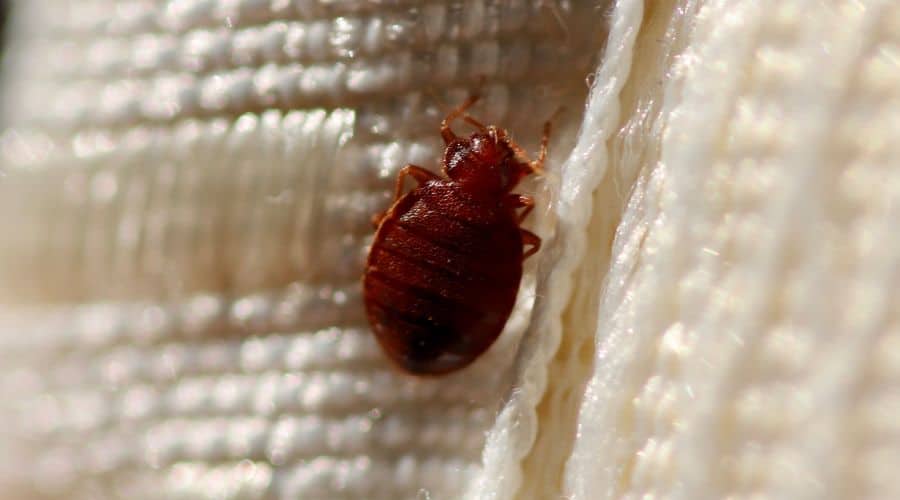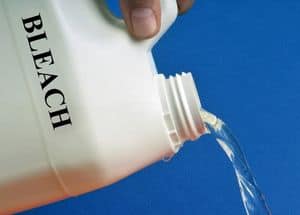Getting rid of bed bugs is never easy. Regardless of the complexity of infestation, it takes your money, time, effort and leads to nervous exhaustion. Many people, when looking for ways to kill these pests, try to minimize stress by calling in professionals. Others cut costs by considering cheap DIY remedies.
And then the question arises: ‘Does bleach kill bed bugs?’. This is a fairly popular method. It is effective in killing pesky bed bugs and their eggs. However, like other methods, in addition to advantages, it has disadvantages. Read more about this below.
[wpsm_titlebox title=”Will Bleach Kill Bed Bugs and Their Eggs?” style=”main”]
Yes, bleach kills bed bugs in all life stages through direct contact. To get rid of them, you need to treat them with a solution of water and bleach (1:1):
- Noticeable accumulations of bedbugs and eggs;
- Mattress;
- Cracks and crevices;
- Wash all textiles with the addition of Clorox.
[/wpsm_titlebox]
Does Bleach Get Rid of Bed Bugs?
Bleach is an all-purpose disinfectant. It is also inexpensive and easy to buy at any store. The aggressive composition of the bleach can really kill these parasites at different stages of development quite quickly. However, it is worth noting that this popular method, although it guarantees the death of many insects, will in no way kill those not treated with a toxic product.
Bleach, in its pure form, will kill pests much faster, but in order not to damage interior elements and not endanger your health by inhaling vapors, it must be diluted with hot water in a 1:1 ratio. On the contrary, too little concentration will give no results, or they will be minimal, which will not help you completely get rid of a serious bed bug infestation.
[su_youtube url=”https://youtu.be/IBCgAdQTBD0″]
Does Bleach Keep Bugs Away?
Will Clorox bleach kill bed bugs? Many people know that it effectively destroys pests’ bodies on contact. However, this remedy alone will not cope with a large population since you will not be able to find all the bed bugs because they hide in hard-to-reach places. These insects hate the smell of bleach and can escape from one room and infect surrounding areas.
Therefore, using a bleach solution is one of the best methods to prevent reinfection. Once you’ve eliminated unwanted guests from your home, treat all rooms with chlorine, and they won’t come back as they avoid the toxic chemical. For the prevention to have a lasting effect, you will need to thoroughly clean all rooms using this product from time to time.

How Does Bleach Kill Bed Bugs?
Almost all bleaches on the market have the same composition:
- Sodium hypochlorite;
- Water;
- Sodium carbonate;
- Sodium chloride;
- Sodium chlorate;
- Sodium polyacrylate;
- Sodium hydroxide.
These components guarantee disinfection, bleach your linen, remove stains and prevent dirt from re-eating into the fabric during washing. The key active ingredient in this product is sodium hypochlorite. It helps to get rid of annoying bed bugs. Sodium hypochlorite destroys protein. The exoskeleton of an adult individual consists of proteins.
The bodies of nymphs and eggs have a thin protective layer, which is even more easily destroyed. That is why after applying bleach to visible pests, they die. However, this does not happen instantly. When using a solution with water, the bugs die in about two days. Bleach in its pure form gives more impressive results but carries a greater risk to your health and can damage furniture.
[su_youtube url=”https://youtu.be/BIwiqwMQLX4″]
How To Kill Bed Bugs: Bleach Treatment
If you still decide to use this method, take care of personal protective equipment. Wear a mask to protect your lungs from toxic fumes and gloves. Open all the windows. After treating the house, leave it for at least a few days.
If children and animals live in your home, it is better to select other methods since contact with bleach, ingestion, and inhalation are very harmful to them. Be sure to incorporate other effective methods into your strategy, such as a steam cleaner treatment, as you won’t be able to treat all hard-to-reach areas with bleach.
- Remove unnecessary garbage and hide all items in plastic bags;
- Vacuum all rooms thoroughly and throw away the bag;
- Gather all textiles, including blankets and bedding. Wash them at the maximum allowable temperature with the addition of detergent and bleach;
- Mix in equal proportions any bleach and hot water. Pour into a spray bottle;
- Treat the mattress and spring block with this compound (the mattress cannot be used for at least 2 weeks after treatment);
- Spray visible individuals, eggs, cracks, and crevices;
Treat the drawers of cabinets and bedside tables, window and door frames with a solution.
Pros and Cons of Using This Method
Before choosing this method, think about the possible results of the treatment and evaluate the risk to your health.
Advantages
- Cheap and readily available chemical;
- Effectively kills bed bugs at all stages of development upon contact;
- Pests cannot develop resistance to it;
- Easy to use.
Disadvantages
- May be harmful to human and pets health;
- Cannot be used on delicate surfaces and dyed fabrics;
- Does not kill those bedbugs that have not come into direct contact with bleach.
FAQ on Bed Bug Control With Bleach
To successfully control insects, you need to know the nuances of the method you want to use.
Can bed bug eggs survive bleach?
This is impossible if they have been subjected to direct contact with a bleach solution. This chemical destroys the protective shell of adult pests, nymphs, and eggs.
Does bleach or Clorox kill bed bugs?
You can use any bleach product, and it will kill the pests on contact. Clorox is the most popular bleach on the market, with a proven track record.
Does bleach instantly kill bed bugs?
No, for bed bugs to die, you need to spray them with a bleach solution. After treatment, sodium hypochlorite gradually kills pests. This complex process takes at least 48 hours.
Household Chemical Can Be a Powerful Insecticide
Bleach is widely used for a variety of tasks, one of which is getting rid of bed bugs. It actually kills adults, nymphs, and eggs when you spray the solution directly on them. However, if you want to get rid of insects completely, you need to use 2–3 more effective methods to kill those bugs that hide in the crevices and inside the mattress.
Do not use the treatment if you have lung disease or are prone to allergic reactions. Otherwise, bleach can help kill a lot of pesky critters.
Did you know about this use of Clorox?
Also read:
References
- Parasites. Biology: https://www.cdc.gov/parasites/bedbugs/biology.html
- Unfolding Bleach’s Bug-Killing Secrets: https://www.science.org/content/article/unfolding-bleachs-bug-killing-secrets
- Bed bug aggregation on dirty laundry: a mechanism for passive dispersal: https://www.ncbi.nlm.nih.gov/pmc/articles/PMC5620066/
- How to Find Bed Bugs: https://www.epa.gov/bedbugs/how-find-bed-bugs
- Bleach Toxicity: https://www.ncbi.nlm.nih.gov/books/NBK441921/

